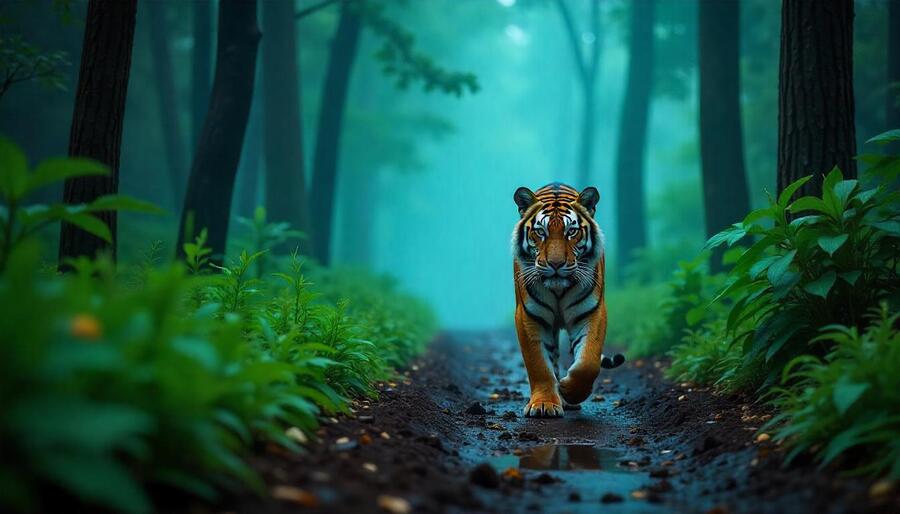Famous Ranthambore Safari – Eye to eye with the Tiger in 2025

Ranthambore Safari — it had been on my mind for years. As dawn broke over the rugged landscape of Rajasthan, I found myself on the threshold of an adventure I had long anticipated.
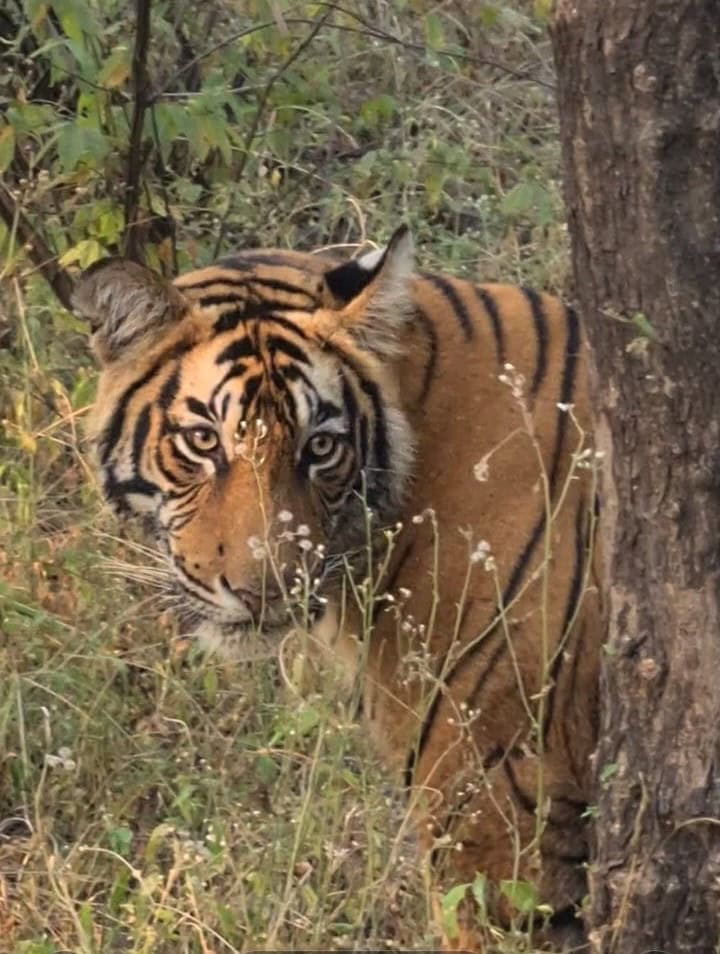
Nestled between the Banas and Chambal rivers, the Ranthambore National Park is a sanctuary – a tapestry of history and wilderness, where ancient ruins stand sentinel over thriving ecosystems.
Dirt Roads and Jungle Whispers at the start of the Ranthambore Safari
The journey from Delhi to Sawai Madhopur, the gateway to Ranthambore, in Rajasthan was a blend of anticipation and curiosity. The town, with its rustic charm, seemed to whisper tales of bygone eras. As I approached the park’s entrance, the imposing Ranthambore Fort loomed atop a hill, a testament to centuries past. The fort’s ancient walls, built in the 10th century by the Chahamanas of Ranastambhapura, have witnessed the ebb and flow of time, standing resilient amidst the ever-changing landscape.
As I stood at the base of Ranthambore Fort, towering 700 feet above me, I couldn’t help but imagine the battles, betrayals, and power struggles that once played out here. Built as an impenetrable stronghold, it was the ultimate trophy for rulers—passing from the Chauhans to the Delhi Sultanate, the Mughals, and finally, the Kachwaha Rajputs. Even Prithviraj Chauhan ruled from here before Alauddin Khilji stormed in, capturing it in 1301. Over time, it became a chess piece in Akbar’s empire, then lost its military charm and turned into a royal hunting retreat—the precursor to today’s Ranthambore National Park.
But this fort isn’t just about power—it’s about resistance. Rana Hammir Singh held his ground against the Mughals, and when defeat was inevitable, Rajput women embraced the heartbreaking tradition of Jauhar, choosing fire over dishonor.
Even in its ruins, Ranthambore Fort is breathtaking. Sprawling over 7 km, its massive stone walls, grand gateways, and hidden passageways whisper stories of the past. The Ganesh Temple still draws pilgrims, the Jain shrinesshowcase intricate carvings, and the Badal Mahal (Palace of Clouds) offers views that make the climb totally worth it.
Today, the Ranthambore Fort is a UNESCO World Heritage Site, recognized as part of the Hill Forts of Rajasthan. Unlike other forts that stand isolated on barren hilltops, Ranthambore is uniquely surrounded by dense forests, home to tigers, leopards, and sloth bears. The contrast of ancient stone against lush greenery makes it one of the most picturesque historical sites in India.
For visitors, climbing to the fort is an experience in itself. The winding path, flanked by old stone walls and mystical ruins, often echoes with the cries of langurs and peacocks. Occasionally, a leopard might be spotted near the walls, a reminder of how nature and history have intertwined in this landscape for centuries.
Dust, Roars, and Anticipation: The Thrill of the Open Jeep
The morning air was crisp as I boarded the open jeep, joining a small group of fellow enthusiasts for our Ranthambore forest safari. Our guide, a seasoned naturalist, briefed us on the day’s itinerary and the code of conduct within the park. As we ventured deeper, the symphony of the wild enveloped us—the distant call of a peacock, the rustle of leaves, and the harmonious chirping of countless birds.
Ranthambore unfolded before me like a wild, untamed canvas, a mix of golden grasslands, dense forests, and rugged ridges stretching into the horizon. Towering Dhok trees ruled the landscape, their twisted branches standing strong against the elements, while banyans, bamboo groves, and bursts of Flame of the Forest added layers of colour and mystery.
The Aravalli and Vindhya ranges meet here, shaping rolling hills and plateaus that felt like they belonged in a forgotten legend. And then, the lakes—Padam Talao, Rajbagh Talao, and Malik Talao—each a shimmering oasis where the wild came to drink, play, and survive. Padam Talao, the largest, was pure magic, its still waters reflecting the grandeur of Jogi Mahal, a red sandstone retreat that whispered of kings and lost eras.
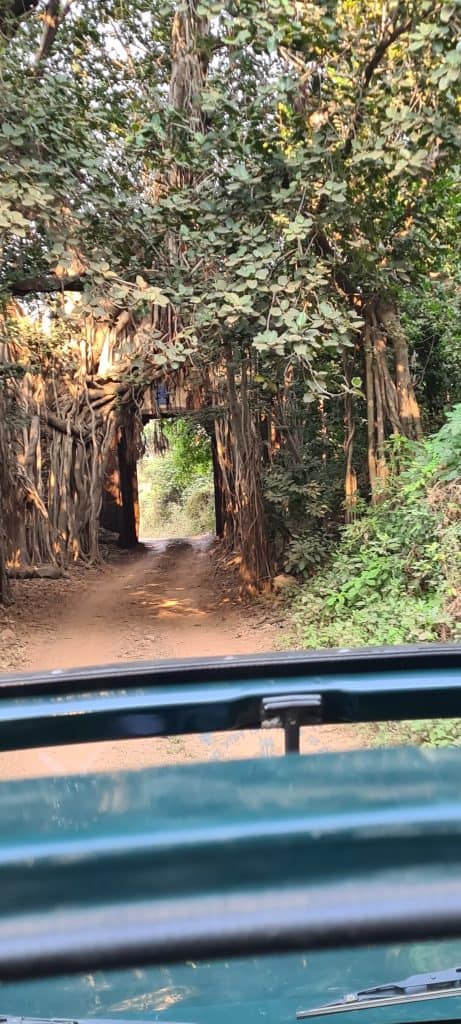
The park’s flora is as diverse as it is stunning, with over 300 species of trees, each playing a part in this raw, vibrant ecosystem. The towering trees, hidden groves, and flowering canopies create a haven for life—especially for birds. A Ranthambore safari is a birdwatcher’s paradise, as the park is home to over 270 species. Honestly, a jeep safari in Ranthambore National Park, is the best way to see the forest, its animals, and all the beautiful birds.
A peacock, glistening in shades of blue and green, paraded like it owned the place. Above, a Crested Serpent Eagle perched high, scanning the ground like a watchful ruler. The flash of an Indian Roller’s brilliant blue wings caught my eye, while the Painted Francolin played hide-and-seek in the underbrush. Near the lakes, an Indian Paradise Flycatcher danced in the air, its long, ribbon-like tail feathers trailing like silk in the breeze. It was a different world – alive, untamed, and utterly mesmerizing.
As our jeep navigated the rugged trails of our Ranthambore safari, we encountered a plethora of wildlife. Herds of Chital (spotted deer) grazed peacefully, their dappled coats blending seamlessly with the sun-dappled forest floor. The larger Sambar deer, with their coarse, dark brown fur and imposing antlers, observed us curiously.
A family of Wild Boars scurried across the path, and in the distance, the elusive Indian Gazelle, or Chinkara, could be seen nibbling on sparse vegetation. Our guide pointed out fresh tracks of a Sloth Bear, though the reclusive creature remained hidden from our view. The park’s diverse flora, from the hardy Dhok trees to the flowering Flame of the Forest, painted the landscape in hues of green and crimson.
Legends of the Striped Royals: Tales of Famous Tigresses sighted during Ranthambore Safaris
Ranthambore’s fame is intertwined with its legendary tigresses, each contributing to the park’s rich narrative. Foremost among them is Machali, often referred to as the “Queen Mother of Tigers” or the “Lady of the Lakes.” Born in 1997, Machali was renowned for her hunting prowess, notably her fearless battle with a 14-foot mugger crocodile, a feat that earned her the moniker “Crocodile Killer.” Over her lifetime, she birthed eleven cubs, significantly bolstering the tiger population in the park. Her lineage is said to constitute a substantial portion of Ranthambore’s tiger populace, and her legacy continues to draw visitors from around the globe.
As we rumbled along the dusty tracks of our Ranthambore safari, our jeep driver, shared, “Everyone knows about Machali,” he said, gripping the wheel with ease. “But do you know about the other queens of this jungle?”
Before I could answer, our naturalist and guide, leaned forward, adjusting his binoculars. “Ranthambore isn’t just a park,” he said with a grin. “It’s a kingdom. And trust me, the tigresses are the real rulers here.”
Sundari (T-17) – Machali’s Fierce Daughter
“See that patch of dry grass ahead?” Our guide and naturalist pointed toward an open stretch by the lake. “That was once Sundari’s domain—Machali’s daughter. She wasn’t like her mother, though—more fire, less patience. She was a warrior. Fought her way into the best territory, defended it against intruding males, and raised cubs like a true queen. No hesitation, no fear. She took what was hers.”
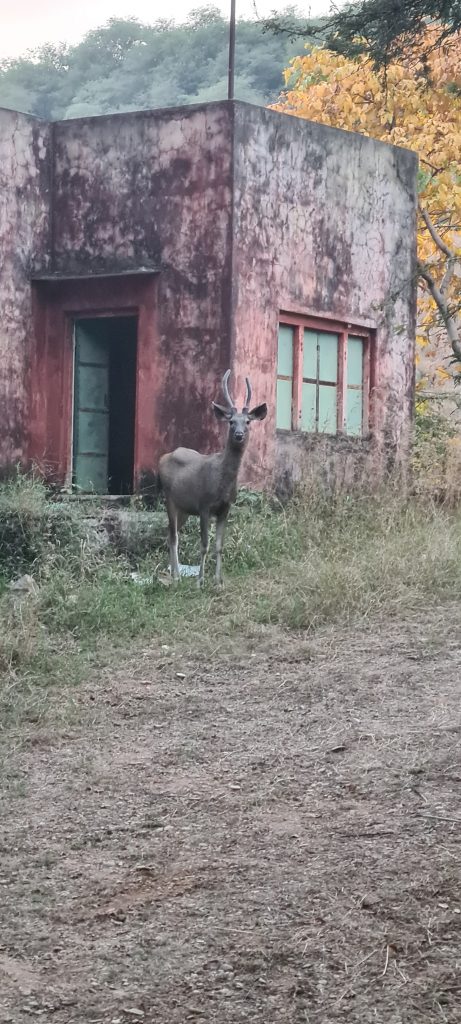
Krishna (T-19) – The Ultimate Queen Mother
The jeep slowed as we passed the ruins of an old hunting lodge. The seasoned guide and naturalist scanned the area. He is a master of the tiger safari in Ranthambore. “This used to be Krishna’s playground. Machali’s other daughter. But she wasn’t just a ruler—she was a mother. A legend.”
Our jeep driver nodded in agreement. “You see Arrowhead? Lightning? Pacman? They’re all her blood. She raised cubs like no other tigress, teaching them how to rule. Krishna wasn’t just about power—she played the long game.”
Arrowhead (T-84) – The Instagram Queen
As we approached Padam Talao, the grand lake shimmering in the sunlight, our Naturalist shared, “If Machali was the Queen, and Krishna the Mother, Arrowhead is the Influencer. “Everyone has a picture of her – Lounging by the lake, strutting through the ruins. She knows she’s being watched and plays along. But don’t be fooled—she’s a killer when she needs to be.”
Noor (T-39) – The Shadow Queen
We turned into the deeper jungle, the trees closing in. The driver lowered his voice, “This is Noor’s land. She’s different—prefers the dark, the hills, the places no one bothers to look.” His’s eyes darted around. “She’s not one to seek attention, but she’s one of the toughest. She’s fought off males, raised cubs in the roughest terrain, and survived battles most wouldn’t.”
Sultana (T-107) – The Rising Star
As we neared the Banas River, the driver’s voice took on a note of excitement. “Now, keep an eye out. If luck is on our side, we might spot a future legend—Sultana. She’s still young, but she’s got Noor’s blood, and that means she’s got fire in her veins. She’s learning fast—hunting near the river, testing boundaries. One day, she might rule this jungle.”
The jeep stopped for a moment. The jungle felt alive, the weight of its history pressing down on us. “This place isn’t just about spotting tigers,” the naturalist said softly. “It’s about understanding them. Every tigress that has ruled here has left her mark—not just on the land, but on the generations that follow.”
The jeep driver nodded. “Their stories don’t end. They just pass from one queen to the next.”
And just as he finished speaking, a low rumbling growl echoed through the trees.
The Elusive Stripes: A Memorable Tiger Sighting
The jungle had gone eerily still. The low, growl rolled through the trees, sending a shiver down my spine. It wasn’t the distant kind—it was close, primal, almost like the jungle itself was breathing.
The air tightened around us. No one spoke. Even the rustling leaves seemed to pause, as if waiting. Each creak of the forest floor, every whisper of movement in the underbrush sent our hearts racing. We sat, gripping the edges of our seats, pulses pounding with anticipation. The wait stretched on, minutes feeling like hours, until — A shrill cry.
First, the Langurs, their frantic alarm calls ringing through the treetops, bouncing from branch to branch. Then, a deep, guttural warning from a Sambar deer nearby. This was it.
” Its a male tiger. He has killed a deer this morning. He’s close,” Our driver whispered, his voice barely audible over the pounding silence. He barely touched the jeep’s accelerator as we crept forward, following the urgent calls of the jungle’s sentinels. The path was narrow near a steep hillside, flanked by thick jungle bush and dense shrubs, their tangled branches reaching out like grasping fingers.
The air was thick with the scent of damp earth and crushed leaves, the heavy undergrowth pressing in on both sides. Towering trees arched overhead, their dense canopy filtering the golden light into shifting patterns on the forest floor. The occasional rustle within the tangled thicket sent a thrill down my spine—something was moving, hidden but watchful.
It was difficult to see. Vines twisted around fallen trunks, and thick ferns clung to the cracks in the stone, nature’s relentless grip reclaiming everything in sight.
And then—he appeared. From the shadows of the dense undergrowth, the tiger stepped straight towards where we were parked. He was breathtaking. Hisr coat, a radiant tapestry of yellow and black, shimmered as the sunlight kissed his muscular frame.
He walked through a clearing and our jeep reversed to keep up with him. He ignored us as his powerful shoulders rolled effortlessly. And yet, despite his strength, there was an elegance to his movements, a silent, effortless authority that made the world shrink around himr.
His head lifted as he scratched his face with his paw, passed a towering tree, and then, he stopped. His head lifted, piercing amber eyes locking onto ours.
I forgot to breathe.
His gaze wasn’t hostile, nor was it indifferent. It was something else entirely—something that made my heart thud against my ribs. It was acknowledgment. He saw us, he knew we were there, and for that one fleeting moment, it felt like he had allowed us into his world. The sounds of the jungle faded. Time itself slowed, stretching into eternity.
And just as quickly as he had appeared, he turned—graceful, deliberate, untamed. With a final flick of his striped tail, he melted back into the shadows, the jungle swallowing him whole.
We exhaled in unison. No words were spoken. There was nothing to say, nothing that could capture what we had just witnessed. A moment that etched itself into my soul, forever carrying the whisper of the wild..
Sunset Serenade: The Golden Glow over Padam Talao
As the day drew to a close, we made our way to Padam Talao to witness the sunset. The sky transformed into a canvas of gold and crimson, the sun casting its final rays over the tranquil waters. The silhouette of the Jogi Mahal stood in solemn grandeur by the lake, its red sandstone walls reflecting the fading sunlight. Once a royal hunting lodge, it now served as a silent witness to the passage of time. I imagined the bygone era when Rajas and British officers convened here after long hunts, recounting their tales over fireside feasts. The contrast between past and present was striking—where once tigers were hunted for sport, they were now revered and fiercely protected.
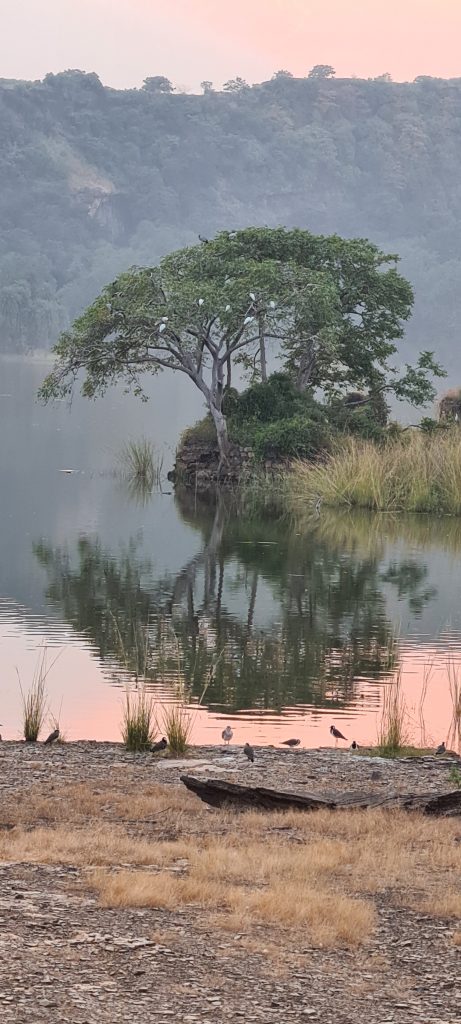
A group of egrets took flight across the lake, their white feathers momentarily ablaze with the fiery hues of the setting sun. A lone crocodile basked on the shore, its ancient form perfectly still, waiting for nightfall to reclaim its dominance over the water. The air was thick with the scent of damp earth and wild jasmine, mingling with the distant call of a jungle nightjar.
The sense of peace was profound.
With dusk settling in, our jeep took a final detour through the park’s hidden relics—ancient temple ruins, crumbling cenotaphs, and stone pavilions reclaimed by nature. The remains of an old hunting palace, once a place of opulence, now lay enshrouded in vines. Peacocks roosted on its moss-covered walls, their haunting cries echoing through the trees.
Ranthambore was more than a national park—it was a living museum, a place where history and wilderness coexisted. Every broken archway and overgrown courtyard whispered stories of an era when the jungle and the royal courts were inseparable.
As we made our way back to the exit, a gentle breeze rustled through the trees, carrying with it the unmistakable scent of sandalwood and wet leaves.
Where the Jungle Breathes: Forests, Lakes and Ancient Hills
That night, as I lay in my hotel room in Sawai Madhopur, I replayed the events of the day in my mind—the thrill of the Ranthambore safari, the beauty of the landscape, the vibrant birdlife, and, most of all, the soul-stirring moment when the tigress locked eyes with me.
Ranthambore had delivered more than just a tiger sighting; it had offered a glimpse into a world where nature, history, and legend intertwined seamlessly. It was a reminder that these forests, these creatures, and these stories must be safeguarded for future generations. The distant call of a hyena punctuated the stillness of the night. I closed my eyes, feeling the wilderness all around me.
Tomorrow, Ranthambore would wake again, its stories unfolding anew beneath the golden light of another sunrise.
Information:
To book a safari in Rajasthan, you’ll need to go through the Government of Rajasthan’s Forest Department or authorized travel agencies. Here’s what you need to know:
Ranthambore online safari booking options: https://www.obms-tourist.rajasthan.govt.in
Ranthambore National Park Online Safari Booking: https://obms-tourist.rajasthan.gov.in/place-details/Rathanbore-Tiger-Reserve
Ranthambore National Park safari booking options Tel: 0141 2923486
Safari Details
- Types of Safaris: Jeep Safari (6 people) and Canter Safari (20 people).
- Zones: 10 zones available, with varying tiger sighting opportunities.
- Timings: Morning and evening safaris, with timings changing seasonally.
Prices
- Jeep Safari: ₹2,000 per seat (Indian nationals) and ₹4,000 per seat (foreigners).
- Canter Safari: ₹1,400 per person (Indian nationals) and ₹3,000 per person (foreigners).
- Additional Information
- Advance Booking: Book your safari up to 90 days in advance.
- ID Proof: Mandatory for each visitor.
- Age Restrictions: No age restrictions, but children under 5 years old can accompany adults.
- Pet Policy: No pets allowed in the park .
| Safari Months : | Ranthambore Safari Timings : |
|---|---|
| From 1st Oct to 31st Oct: | 06.30 am – 10.00 am & 02.30 pm – 06.00 pm |
| From 1st Nov to 31st Jan: | 07.00 am – 10.30 am & 02.00 pm to 05.30 pm |
| From 1st Feb to 31st march | 06.30 am – 10.00 am & 02.30 pm to 06.00 pm |
| From 1st April to 15th May | 06.00 am – 09.30 am & 03.00 pm to 06.30 pm |
| From 16th May to 30th June | 06.00 am – 09.30 am & 03.30 pm to 07.00 pm |
For more information and to book your Ranthambore Tiger safari booking, visit the official website https://obms-tourist.rajasthan.gov.in/place-details/Rathanbore-Tiger-Reserve
Read More: Latest
Table of Contents
What's Your Reaction?
 Like
0
Like
0
 Dislike
0
Dislike
0
 Love
0
Love
0
 Funny
0
Funny
0
 Angry
0
Angry
0
 Sad
0
Sad
0
 Wow
0
Wow
0












































